Mento's Month: April
By Mento 0 Comments
Welcome to the second of these monthly monstrosities, as I aggregate everything I've been writing, playing, and watching over the previous thirty days. At this point, I'm starting to realize I probably blog way too much, so think of this as like the Cliff's Notes version of what I've been up to. Lots of brief summaries and reviews with links to the original articles for those looking for more in-depth takes.
Indie Games of the Month
April comprised the 114-117 entries of Indie Game of the Week, outlined below:
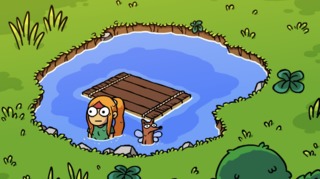
Ittle Dew 2 (IGotW 114) is the sequel to a top-down action-puzzle game that riffed on The Legend of Zelda, but chose to emphasize the puzzles first and foremost: hitting the right switches, pushing blocks on pressure plates, reflecting laser beams around to light up panels, and so on. If you're familiar with the Zelda series, you're probably aware of how those dungeon puzzles tend to go. This is in stark contrast to something like The Binding of Isaac or Enter the Gungeon, which also used Zelda's top-down grid-like approach to dungeons but were geared almost exclusively towards combat. Conversely, Ittle Dew 2 tries to have its Link's A-Cake-ning and eat it too by splitting its gameplay between puzzles and combat alike. It's slightly more polished than the first, with more fun to be had exploring its enormous overworld and its many secret caves, but this divided focus between brains and brawn robs it of the first game's purity of purpose, so to speak. If you're in that intersection on a Venn diagram with "good at real-time boss fights" in one circle and "good at puzzles" in the other, you might want to check it out.
Return of the Obra Dinn (IGotW 115) was one of the biggest surprises of last year: an investigative "logic grid" puzzle game where the goal was to determine how everyone on board a doomed voyage met their maker and in what fashion so that the insurance company you worked for could properly reimburse or penalize their estates. Your only hints came courtesy of a special compass that revealed the scene surrounding a person's demise, and from there you were able to piece together the identity of the body and the cause of death. The whole game is rendered in this striking visual style reminiscent of old computers and relies largely on an atmosphere of dread and foreboding that it nails via its sound design. It's a remarkable feat to create a game that both looks and plays like nothing else on the market, and I was hooked on solving its mysteries for hours.
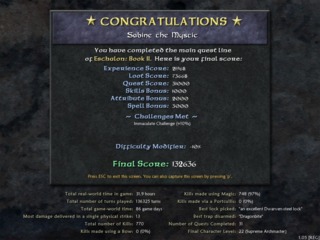
Eschalon: Book II (IGotW 116) is, like its predecessor, a deliberately old-school CRPG experience that hearkens back to the era of Ultima and the isometric top-down CRPGs that followed in its wake. It uses a turn-based structure where everything - enemies, allies, and time itself - only moves ahead when the player character does. Much of the gameplay involves wandering around locations en route to the next story objective, finding side-missions, enemy encounters, and treasure off the beaten path. It's a fundamentally simple RPG that is enhanced by modern quality-of-life improvements that the 80s/90s games it imitates had to do without, making it a fine bridge between the nostalgic past and the present. I appreciate the Eschalon series for emphasizing the simple joys of exploration; setting off in a direction without knowing what to expect, risking your neck in a high-level late game area to abscond with as much of its riches as possible, or coming across a mystery to solve. A bit slow and graphically plain, but compelling enough in its own modest way.
Dex (IGotW 117) was a game where I wasn't sure what to expect beyond a whole lot of cyberpunk shenanigans. What I discovered was a game that attempted to modernize Delphine's Flashback: The Quest for Identity, to a much better degree than the official remake, while also building its missions around a Deus Ex branched approach that accommodates however you've chosen to build out the eponymous heroine's skillset. I didn't care too much for the game's combat - both the hand-to-hand melee combat and the gunplay felt a little awkward, especially in real-time - but it was easy enough to use stealth and hacking skills to quickly end a fight before it started. Despite following a lot of similar story beats and tropes common to the cyberpunk genre, I enjoyed the worldbuilding and character work - I frequently found myself taking on side-missions not just for the money and resources, but to see how those stories end. It also looked pretty cool, putting its characters on a 2D plane with various elaborate futuristic urban backgrounds parallax scrolling behind them.
Hey Everybody, It's the Tuesday Slot
The Tuesday Slot is a forever revolving selection of blog features, sometimes in the form of a short series or one-offs, and occasionally not even showing up on Tuesday:
Tuesday the 2nd - Seeking Warframe & Fortune (Part 3)
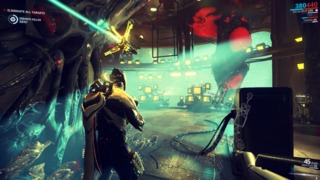
This is where I hit a brief nadir with Warframe, at that point where most people playing a free-to-play game realize that the "complimentary" portion of the game is over and wallets need to start coming out. If you're unfamiliar with what I mean, most free-to-play games give you a bunch of free currency and an early curve that is generous with its unlock progression, only for that to dwindle down now that you've been sufficiently hooked: what remains is determining what kind of fish the game has hooked this time, from the parsimonious sardine to the addiction-prone whale. Warframe's all about taking on these "nodes" - missions around 5-20 minutes long that might have you extermining enemies, hacking computers, defending objectives, or taking on bosses - with a selection of weapons and the warframes themselves, which are like Overwatch heroes in that they have different attacks and combat roles and are occasionally meant to be used in tandem with other synergistic hero types. You get a few weapons right off the bat for next to nothing, but to get the better stuff or more slots to equip them or more warframes to use you either have to be ready for a lot of grinding or pay for them with real money. After this episode, which revealed just how much further I had to go for just the second warframe (after hitting the max level with the first), I started drifting away from Warframe just a smidge.
Tuesday the 9th - Seeking Warframe & Fortune (Part 4)
However, the fact that there was a Part 4 at all meant I hadn't thrown in the towel quite yet. From what I'm able to tell, a lot of warframes are unavailable until the player has made some serious progress with the game, the reason being is that a lot of crafting materials are often unique to specific planets and you need to keep unlocking more of the solar system (by completing quests and nodes) before you have enough for the components you need. Once you're there, it's a simple matter of revisiting planets that have the resources you need to farm for all the weapons and warframes you could want. Like opening the floodgates for content, almost, which modifies my previous "you have to pay money to get the cool stuff" theory into the much fairer "you can pay money to get the cool stuff sooner rather than later" instead. Since the game is almost done introducing new systems at this point, I decided to turn this Seeking Warframe & Fortune feature into one that updates monthly instead of weekly: expect to see more of them throughout the year.
Tuesday the 16th - The Secret Lives of Funko Fantasy (Part 1)
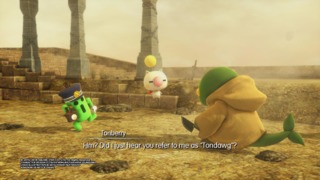
I spent most of April playing the crossover JRPG World of Final Fantasy (see more about the game itself below) and wanted to write something about it for the Tuesday slot, eventually settling on how the game handles its large cast of guest characters from other Final Fantasy games. One thing the franchise is known for, and not always in a positive sense, is how they have all these iconic characters and their journeys from one type of character to another. When you transfer these characters to a new context, like World of Final Fantasy's chibi-fied land of Grymoire, how do you retain the facets of that character that resonate most? Does that involve re-writing their backgrounds to suit this new world? Do you keep the more recognizable version of that character from early in their game before they've completed their character arc, or the more grounded and complete version that appears afterwards? I took a look at all twenty-four of the major Final Fantasy guest characters in WoFF to see how the game handled those dilemmas.
Tuesday the 23rd - The Secret Lives of Funko Fantasy (Part 2)
The conclusion to the above. Part 2 focused on characters from Final Fantasy VIII up to Final Fantasy XIII-2 (Final Fantasy XV only showed up after World of Final Fantasy, though its protagonist Noctis did appear in the enhanced World of Final Fantasy Maxima edition), which meant a lot of voice actors returning to familiar roles. Having characters like Quistis and Celes with voices meant I also finally got to hear how their names were officially pronounced. Overall, WoFF wasn't so serious a game that it felt it needed to treat every character carefully, instead making various goofs at their expense and having a meta in-game "who's who" that was refreshingly frank about the characters and their new iterations from the perspective of the game's developers.
Tuesday the 30th - Bucketlog April: Phoenix Wright: Ace Attorney - Dual Destinies
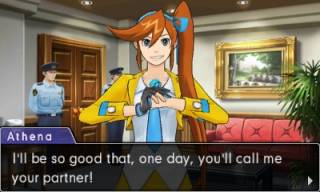
The Bucketlog, which highlights a number of games I've been meaning to play for a long time each from a different console, got itself a gallery seat for one of the more recent offerings from Capcom's always entertaining Ace Attorney series. Dual Destinies modernizes the franchise a little bit, making the investigation stages pass by more quickly and smoothly, and giving everyone 3D models that are able to recreate the nuances and exaggerated reactions of the 2D sprites. There's a distinct sense that the series is recycling its ideas to some extent, but if you think of Dual Destinies as more of a franchise reboot that's establishing some familiar foundations that later entries could build on, then it works in that role. I had a great time with it either way and am looking forward to playing the next game, Spirit of Justice, in the near future.
The Games of April
Spyro 2: Ripto's Revenge (Spyro Reignited Trilogy) (Insomniac Games, 1999/2018)
I'm trying to make the Spyro Reignited Trilogy last, because I'm enjoying these 3D platformer remasrers as little palate-cleansers between the many bigger RPGs I've been playing and will continue to play in 2019. Like Dan, I'd somehow managed to miss this franchise the first time through - rather than being put off by the content, like he was, I think I was just spending all the money I had on PS1 RPGs instead - and now I'm rectified that error slowly but surely. Ripto's Revenge is definitely more polished than the first game was, at least in terms of level design and progression: instead of looking for statues of old dragons to rescue, Ripto's Revenge gives you lots of objectives to complete to acquire its story-critical valuables, putting it more in line with its contemporaries like Banjo-Kazooie and Super Mario 64. Beyond that, it's really just a whole more hoovering up gemstones and other collectibles across a series of thematically varied stages, and that's all I ever ask for from my 3D platformers.
Tappingo 2 (Goodbye Galaxy Games, 2014)
Tappingo's a picross variant where, instead of plotting out squares on a grid based on number clues to build a picture, you drag icons in one of four directions to create a line of colored tiles that stops when it hits something. If you have a gap of five spaces below a tile with a four on it, the idea is to figure out how to fill that last space so the line hits the four it's alloted rather than going over. It's one of those games that's far easier to understand with visuals than verbal descriptions, but it essentially requires the same mix of planning and logic that the traditional picross model demands. Unfortunately, I didn't find any challenge from Tappingo 2, and the vast majority of the puzzles were the same unimaginative circular object with slightly different colorations: planets, balls used in sports, round fruit, etc.. The concept's a sound idea, but for the sequel it felt like the developers had run out of ideas. It was suitable enough as something I could play occasionally on the 3DS, but not a patch on the many excellent picross games already out there.
World of Final Fantasy (Square Enix/TOSE, 2016)
I figured World of Final Fantasy wouldn't keep my attention for long, since it focuses on monster-raising mechanics which I'm generally not keen on, but between the solid Final Fantasy ATB combat, a witty and earnestly silly script and localization, some adorable visuals for the chibi Final Fantasy characters and cute versions of classic FF monsters like "Baby Tonberry" and "Babyhemoth", I found myself buckled up for the entire ride. World of Final Fantasy has a fairly loose structure as its twin protagonists - Reynn and Lann, so named presumably so you could remember who was on the right and who was on the left - bounced around one familiar looking town or dungeon to the next. Its character progression was based loosely on Final Fantasy XIII-2, in that each monster filled a role in combat that could be used to support the team in tandem with others and each had their own "prismarium" in which the player assigned building points to nodes on a grid that either provided new abilities (like spells or attacks) or stat boosts. It's a versatile system that lets players experiment with different sets of abilities and roles, helped with the "mirajewel" system in which each of the protagonists can equip a certain number of abilities to fill gaps that their monster companions lack. Overall, I was impressed with how in-depth this irreverent, throwaway crossover RPG with dopey looking Funko Pop guest characters ended up being, and I'm still considering taking on the game's last few big post-game challenges before I put it away.
Other Distractions
Treasure Planet (2004)

For the longest time I kept confusing this early '00s animated interplanetary adventure featuring a hero with a dumb haircut and father issues with another: Don Bluth's Titan A.E.. Turns out I'd never seen Disney's Treasure Planet, which is exactly as it sounds: a sci-fi retelling of Robert Louis Stevenson's swashbuckling adventure novel Treasure Island. The movie's not too bad, with some decent voice acting (I could take or leave Martin Short's malfunctioning robot ersatz for half-insane castaway Ben Gunn), though the animation felt a bit rough in spots as facial features danced around on certain characters during the more active scenes. It was one of Disney's earliest combinations of CG and traditional animation, and the latter holds up a lot better than the former does. There's some effort and quality here especially in the more Disney friendly focus on the paternal bond between the young Jim Hawkins and the scheming but sentimental lead pirate Long John Silver, but it's not exactly Muppet Treasure Island and, honestly, precious few Treasure Island adaptations are.
Incredibles 2 (2018)
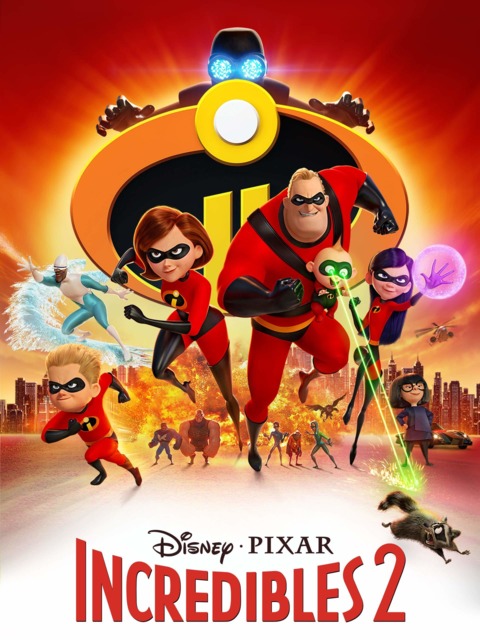
The first Incredibles was all about trying to live in a world where those with exceptional talents were suppressed - rather than stopping heroes running around like vigilantes, it seemed more like the government was against the idea of them using their powers in any context - and the second builds on that by focusing on public perception of superheroes and how it can be easily manipulated by someone with the right or wrong agenda. Following the titular family of superheroes, it's a movie that splits its time between the more familiar Disney territory of a family banding together in times of adversity with high-concept musings on the nature of celebrity and whether or not superpowered people should be allowed to run around causing property damage and endangering civilians for the greater good. It's a little more rudderless than the first, but a great showcase for its voice talent, CG animators, and clever scriptwriters, especially where the movie's chaotic last act is concerned.
Teen Titans Go! To the Movies (2018)
I hadn't watched any of the Titan Titans Go! show, which is a more irreverent kid-focused riff on the original Teen Titans cartoon and the DC universe in general, but the movie seemed well regarded and I guess I was still in the mood for more animated superhero business after Incredibles 2. I'd put this somewhere in the same realm as the first Lego movie: there's definitely an emphasis on a younger audience between its central message of "be there for your friends" and the many poop jokes, but there's enough callbacks and jokes and references that an older audience would appreciate that would make it worth their time, whether they have kids or not. It skewed a little young for me and I really didn't care for the musical numbers, but I liked some of its more silly humor and an inspired mid-movie sequence where the Teen Titans decide that - if they're going to get their own movie (literally their only goal for this movie) - they need to ensure that they're the only superheroes around, going back in time to undo (and later redo) all the other DC superhero origin stories.
Looking Ahead
May's a surprisingly quiet month. Well, maybe not "surprisingly". There's a reason I do a big May blog series every year: the month is almost always bereft of new releases to be excited about, and most of the big news is being saved for E3 season in the following month of June. Still, there's a handful of May games I might be tempted to try out:
- A Plague Tale: Innocence and Rage 2 both come out on the 14th, and I could go either way for either of them. A Plague Tale's popped up in a few E3 trailers now, demonstrating some really unsettling "rat horde" tech as its peasant protagonists attempt to escape waves of omnivorous rodents in a period of time that was hard enough to survive on its own. Of course, historical experts have since determined that those furry little rascals had nothing to do with the spreading of plagues during the middle ages, but Dishonored really made a case for Mr. Squeakers being a vicious enough threat without getting the black death involved. Rage 2, meanwhile, is one of several day-glo post-apocalyptic open-world games that I'm hoping is a little more imaginative than Far Cry: New Dawn and way more competently put together than Fallout 76 - the bar isn't exactly astronomically high for a good one of these this year, barring maybe Metro Exodus, but it remains to be seen if Bethesda, id Software, and Avalanche can turn the divisive Rage into a game series worth salvaging. After all, salvaging is what post-apocalyptic dwellers are good at.
- Slim pickings for the rest of the month. There's the Tacoma-esque voyeuristic space station horror adventure game Observation; Team Sonic Racing, the newest kart racer from a mascot who has a lot of goodwill he needs to earn back; Total War: Three Kingdoms, for those who find Koei Tecmo's Romance of the Three Kingdoms war sims to be too slow or Japanese; and a whole lot of ports, including Saints Row: The Third, Assassin's Creed III, Resident Evil, RE 4, and RE 0 for Switch and Yakuza Kiwami 2 for PC.
No "must buys" for me this month, but perhaps that's for the best: I have enough backlog games to keep me company for this and several more summers. June will be more exciting, I suspect: not only will we get Judgment and Super Mario Maker 2 (in the same week, even) but E3 usually carries with it a lot of surprise releases and other news. See you then.
